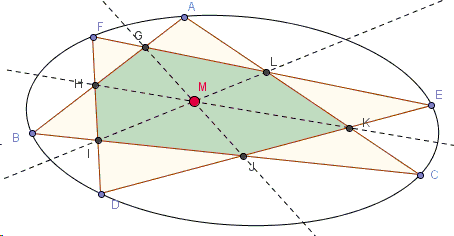Two Triangles Inscribed in a Conic - with Elementary Solution
Jack D'Aurizio
The following ideas come from Gabriel Giorgieri, and I am grateful to him. (The theorem below constitutes the statement suggested by Vladimir Nikolin and generalized by Hubert Shutrick.)
Assume that two triangles \(ABC\) and \(DEF\) are inscribed in the same conic and intersect in six points \(G,H,I,J,K,L.\)

Then the lines \(GJ\), \(HK\), \(IL\) are concurrent.
(The applet below illustrates the proof. Points \(A\), \(B\), \(C\), \(D\), \(E\), \(F\) are draggable.)
Proof
Without loss of generality, we can assume that the circumscribed conic is a circle. If we call \(X\) the intersection of \(CF\) and \(BE,\) \(Y\) the intersection of \(AD\) and \(CF,\) \(Z\) the intersection of \(AD\) and \(BE,\) by the Pascal theorem we know that \(G,\) \(Y,\) \(J\) are aligned, and the same holds for \(H,\) \(X,\) \(K,\) and \(I,\) \(Z,\) \(L.\) So we only need to prove that \(GY,\) \(HX,\) \(IZ\) are concurrent cevians with respect to the triangle \(XYZ\).

In order to apply the Trig Ceva theorem, we express the ratio \(\displaystyle\frac{\mbox{sin}(ZXK)}{\mbox{sin}(KXY)}\) by exploiting the fact that in \(\Delta BFX\) the cevians \(KX,\) \(AB,\) \(DF\) concur in \(H.\) What we get is:
\(\displaystyle \begin{align} \frac{\mbox{sin}(ZXK)}{\mbox{sin}(KXY)} &= \frac{\mbox{sin}(HXB)}{\mbox{sin}(HXF)} \\ &= \frac{\mbox{sin}(BFH)}{\mbox{sin}(HFX)} \cdot \frac{\mbox{sin}(HBX)}{\mbox{sin}(HBF)}, \end{align} \)
so, by denoting with \([UV]\) the sine of half the angle between \(U\) and \(V\) in the circumcircle of \(\Delta ABC,\) we get:
\(\displaystyle \frac{\mbox{sin}(ZXK)}{\mbox{sin}(KXY)} = \frac{[BD]}{[CD]} \cdot \frac{[AE]}{[AF]}, \)
and, in the same way:
\( \displaystyle\frac{\mbox{sin}(XYG)}{\mbox{sin}(GYZ)} = \frac{[CE]}{[AE]} \cdot \frac{[BF]}{[BD]}, \\ \displaystyle\frac{\mbox{sin}(YZI)}{\mbox{sin}(IZX)} = \frac{[AF]}{[BF]}\cdot \frac{[CD]}{[CE]}. \)
The product of the last three right-hand sides is one, proving that the lines \(XK,\) \(YG,\) \(ZI\) are concurrent, QED.
As already noted, this concurrence of Pascal lines is different from the ones stated by Steiner and Kirkman. This theorem should have a proper name! :)
Menelaus and Ceva
- The Menelaus Theorem
- Menelaus Theorem: proofs ugly and elegant - A. Einstein's view
- Ceva's Theorem
- Ceva in Circumscribed Quadrilateral
- Ceva's Theorem: A Matter of Appreciation
- Ceva and Menelaus Meet on the Roads
- Menelaus From Ceva
- Menelaus and Ceva Theorems
- Ceva and Menelaus Theorems for Angle Bisectors
- Ceva's Theorem: Proof Without Words
- Cevian Cradle
- Cevian Cradle II
- Cevian Nest
- Cevian Triangle
- An Application of Ceva's Theorem
- Trigonometric Form of Ceva's Theorem
- Two Proofs of Menelaus Theorem
- Simultaneous Generalization of the Theorems of Ceva and Menelaus
- Menelaus from 3D
- Terquem's Theorem
- Cross Points in a Polygon
- Two Cevians and Proportions in a Triangle, II
- Concurrence Not from School Geometry
- Two Triangles Inscribed in a Conic - with Elementary Solution
- From One Collinearity to Another
- Concurrence in Right Triangle

|Contact| |Front page| |Content| |Geometry|
Copyright © 1996-2018 Alexander Bogomolny
73512274
